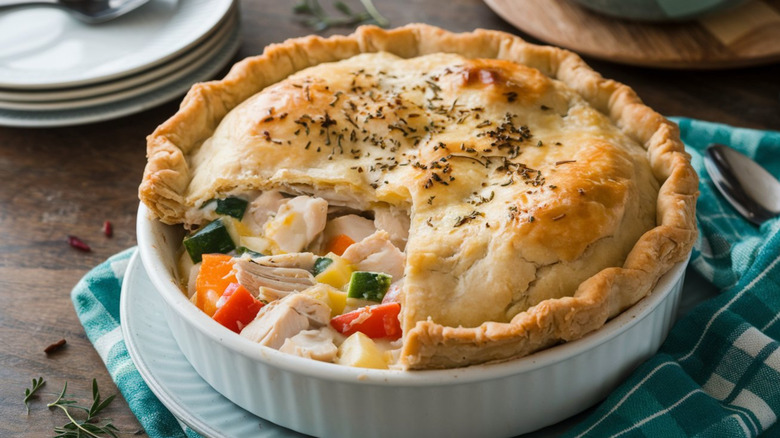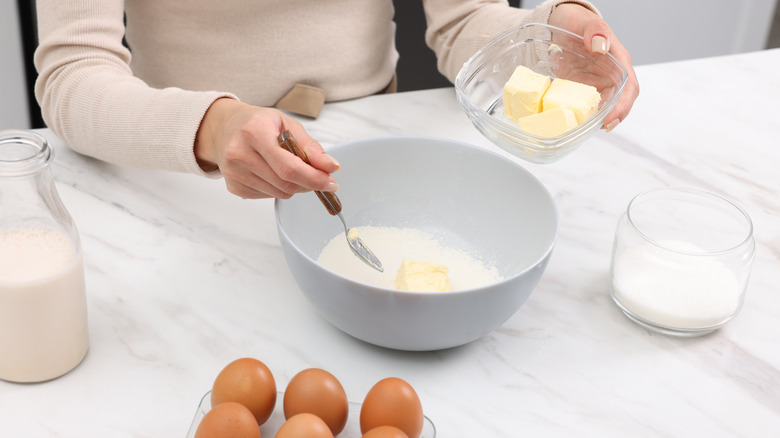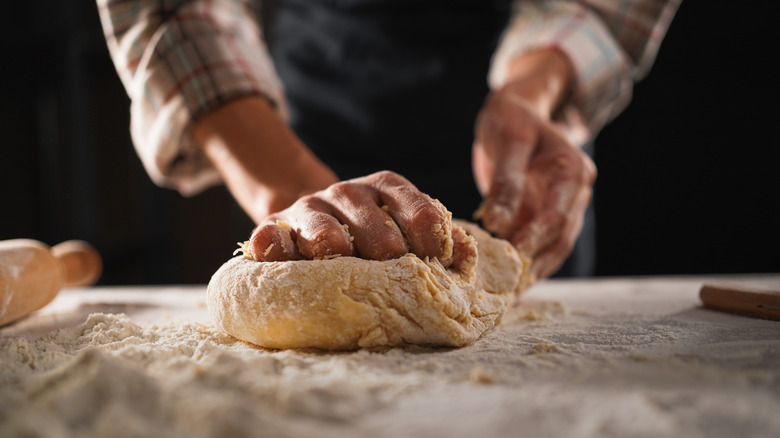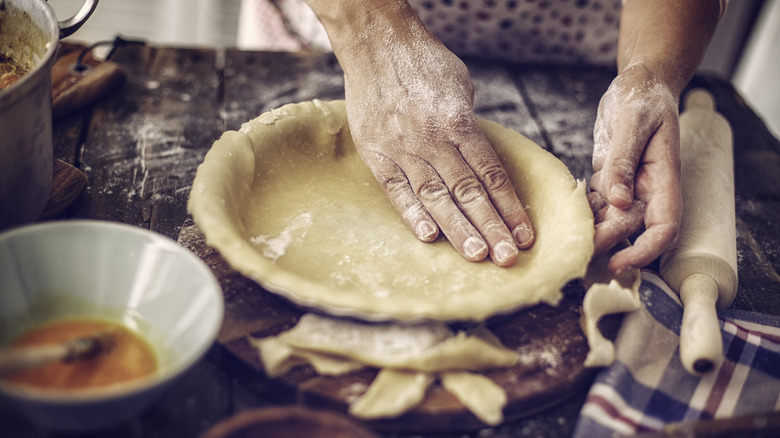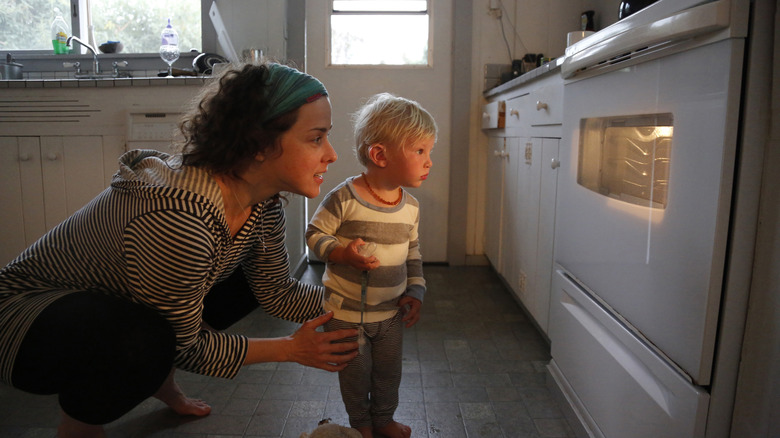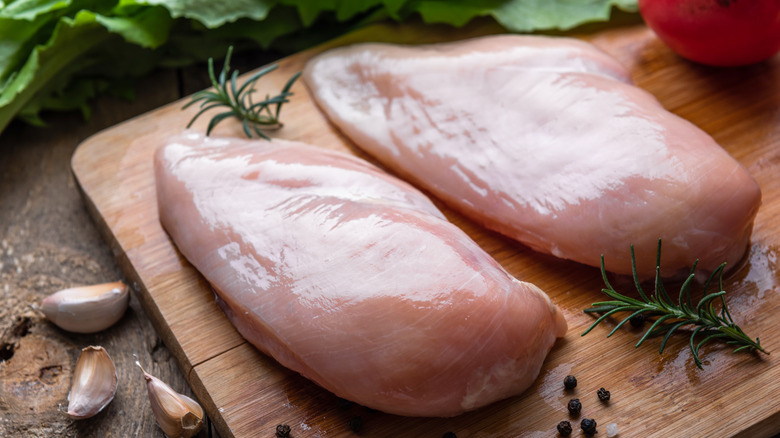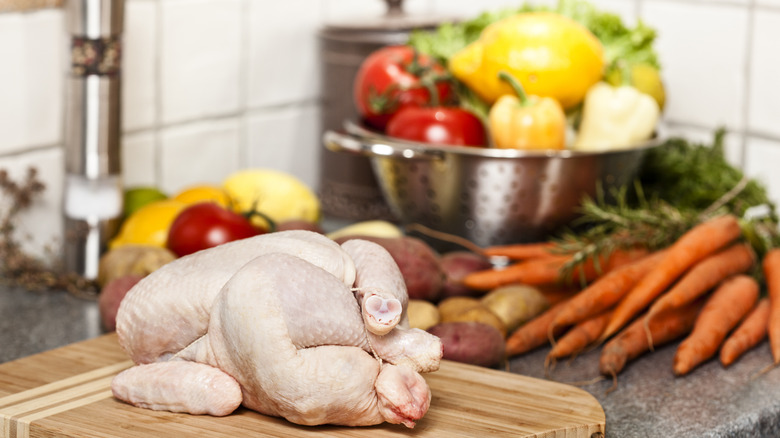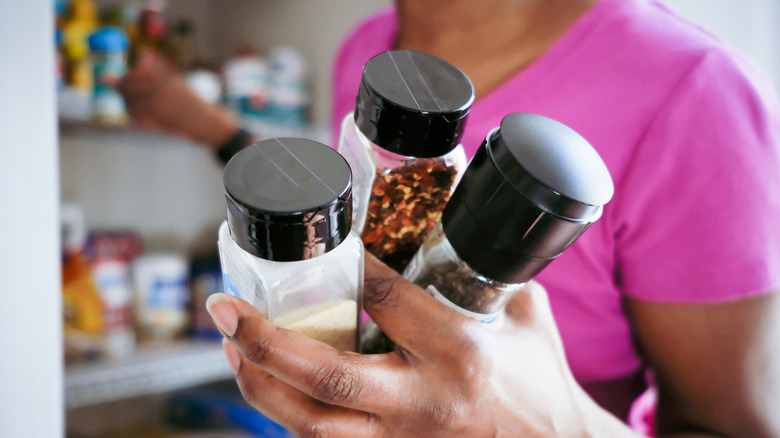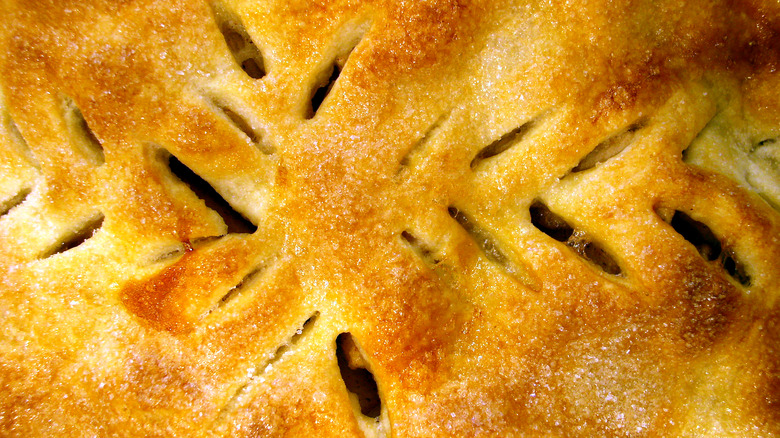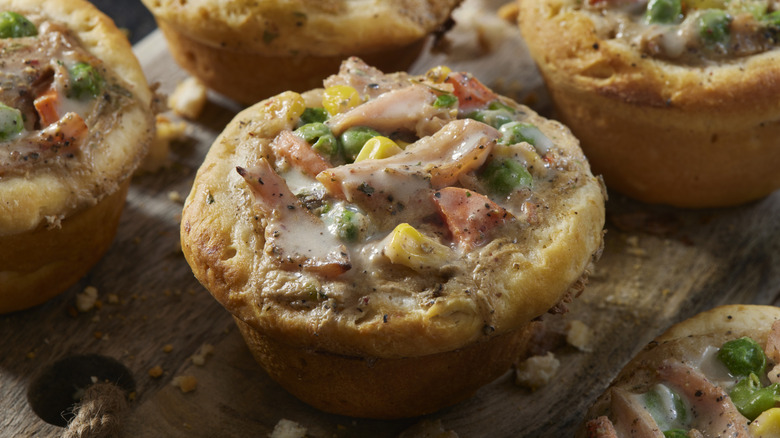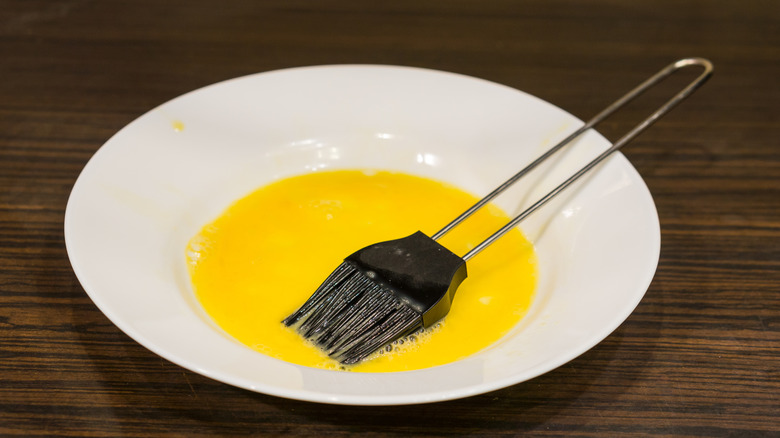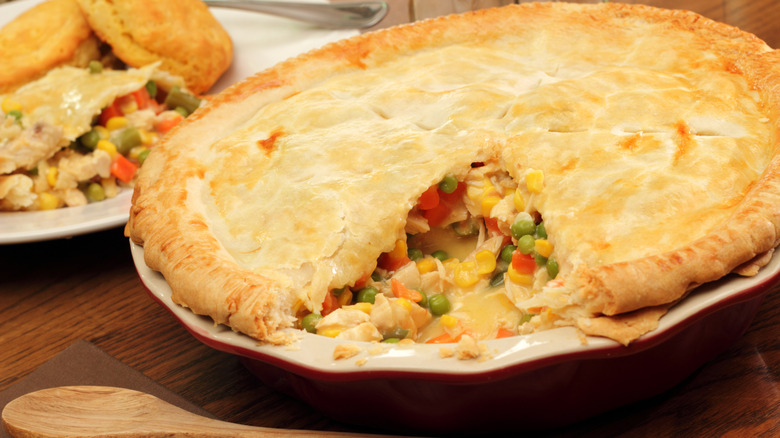The Most Common Mistakes People Make With Homemade Chicken Pot Pies
Combining crispy pastry and a hearty filling, chicken pot pie is a classic dish that's unlikely to go out of style any time soon. The savory meal brings together tender chicken pieces, vegetables, spices, and a creamy sauce, all enveloped in a flaky crust. While this dish is customizable, some of the more popular chicken pot pie veggie choices include onions, celery, carrots, and leeks, since they are good at maintaining their texture.
While making chicken pot pie may seem easy, the process involves a number of steps, including preparing the pastry and filling and then putting the two components together. This means that mastering the art of making the perfect chicken pot pie can be time-consuming — even a small misstep can throw off the balance of flavors or leave the crust soggy and unappealing. Luckily, a little patience and know-how can go a long way. Guidance on things like kneading the dough and serving the final dish can prevent costly mistakes. So we tapped a few professionals to share their expertise in the kitchen.
Ready to try your hand at a flawless chicken pot pie? Take a look at the most common mistakes people make when preparing this classic dish and how to avoid them!
Failing to add enough cold butter to the crust
Most chicken pot pie recipes call for butter — and for good reason. It's precisely this ingredient that gives the crust a light and crispy consistency due to its high water content. When the crust is placed in the oven, the water in the butter evaporates, creating steam that expands and forms air pockets. As the steam escapes, the remaining butter fat helps to maintain these pockets, resulting in a flaky pie crust.
According to chef Steve Chiappetti, who oversees the culinary program at theWit hotel in Chicago, when it comes to pie dough, the more butter, the better. And he knows what he is talking about — the State and Lake Chicago Tavern, under Chiappetti's culinary direction, features pot pie on its menu. "Butter is essential for creating a rich, flavorful, and tender crust. ... If you skimp on butter, the result will be dry, crumbly dough that lacks the signature flakiness, a bland crust that doesn't add much to the dish, [and] a tougher texture that is harder to cut and less enjoyable to eat."
Chiappetti says the second mistake home chefs make when it comes to pot pie crust is using softened or room-temperature butter. "For a flaky, tender crust, the butter in pie dough must be cold when mixed into the flour. ... Cold butter creates small pockets of fat, which melt in the oven and form the crisp, delicate layers we associate with a great crust. If the butter is too warm, it blends too much with the flour, resulting in a dense, tough crust rather than a flaky one," he says.
Over-kneading the dough
Classic chicken pot pie crust consists of just four ingredients — butter, flour, salt, and water. In a pinch, you can even use canned biscuits to make chicken pot pie crust. However, if you decide to make your own pie crust, you will need to handle the dough with care. This is because over-kneading it can create a tough, dense crust instead of the light, flaky texture that we all love in a chicken pot pie.
While it's important to bring the dough together, overworking it can lead to disaster, says chef Steve Chiappetti. "It's a common pitfall! Kneading develops gluten, which is great for bread but can make pie crust tough and chewy rather than light and flaky," he says. "To avoid this, mix just until the dough comes together, then let it rest in the refrigerator before rolling it out." According to Chiappetti, there are several tell-tale clues that you have over-kneaded your dough, including dough that is difficult to roll out and shrinks when baked.
Blair Lonergan, recipe developer and founder of the recipe site The Seasoned Mom, says that overworking pie dough can also make it overly warm, creating the same temperature issues that using warm butter causes. "If the butter is too warm and you overwork the dough, the butter becomes incorporated into the dough, creating a more dense, less flaky texture," she explains.
Not par-baking the bottom crust of the pie
Once you have your pot pie crust dough ready, it's time to ensure that it cooks up properly in the oven. If your pot pie has a base, instead of just a pastry lid, it's important to par-bake the lower crust to stop your pie from becoming undercooked or overly soggy at the bottom. Also called blind baking, this method lets the bottom of the pie firm up before any wet filling is added. To stop the lower layer of the crust from puffing up too much — after all, you want to leave enough space for the filling — line it with parchment paper and dried beans or rice for the first 10 to 15 minutes of baking.
Instead of par-baking the lower pie crust, you can also create a barrier between the dough and the filling to prevent any sogginess. This can be done in a number of ways. One method to help ensure that the crust remains crispy is to brush it with an egg wash before adding the filling. Alternatively, you can also shield the bottom crust from moisture by sprinkling it with a little Parmesan cheese or breadcrumbs.
Not assembling the pie correctly, and baking at the wrong temperature
Once the bottom layer of the pie is thoroughly cooked, it's time to assemble the pie and place it back in the oven. For the best result, distribute the filling evenly across the crust before placing the top layer over the filling. Be sure to carefully seal the edges of the pie by crimping them with a fork to ensure that the filling doesn't spill out of the pastry as it bakes in the oven.
To ensure that the chicken pot pie cooks evenly, it's crucial to preheat the oven before placing it inside. The founder of Be Inspired and cookbook author Roberta Muir recommends preheating the oven to around 400 degrees Fahrenheit. "Remember that you lose heat as soon as you open the oven door, so ensure your oven is good and hot ... when the pie goes into it," she says. "Once the pie is in the oven, you can drop the temperature if necessary to whatever the recipe specifies. When cooking with pastry, it's important to follow the temperatures given in the recipe so that the pastry cooks properly without burning."
Using the wrong type of meat
While different culinary experts have different ideas about how to best prepare chicken pot pie, there is little doubt that the quality of the poultry plays a crucial role in the dish. Using fresh, high-quality chicken in the filling results in tender meat that readily absorbs the flavors of the stew. While most chefs recommend using chicken breast for pot pie filling, not everybody is in agreement.
Blogger and author Roberta Muir says that while you can improvise with leftover rotisserie chicken meat, this isn't going to give you the best results. Instead, she recommends using a fresh, whole chicken that's cooked and shredded. Executive chef Josh Evans from Cheddar's Scratch Kitchen likes to use chicken tenders in his chicken pot pie recipe. "Chicken breast can get tough and dry out during the baking process," he says. "I choose chicken tenders because they hold up well and give you a more tender bite."
Failing to cook the meat and vegetables correctly
While we all know that overcooking or undercooking veggies can lead to a truly underwhelming pot pie, improperly cooked poultry can make it unsafe to eat. Poultry cooked at high temperatures can produce heterocyclic amines and polycyclic aromatic hydrocarbons, both of which can lead to harmful changes in DNA. Undercooked poultry, on the other hand, can lead to food poisoning. Blogger and author Roberta Muir says she prefers to lightly poach a whole chicken — place the chicken in boiling water, cover the pot with a lid, and take it off the stove. Let the chicken rest in the pot for at least 20 minutes until it's fully cooked, then slice, dice, or shred it. "I poach chicken lightly for pot pies, so that it remains juicy, and the poaching liquid becomes stock that I can freeze for another dish or use in the sauce if I'm not making it with milk or cream," she explains.
Picking the right vegetables for your chicken pot pie filling is also crucial to the overall texture of the filling, according to executive chef Josh Evans. More specifically, Evans recommends using onions, carrots, celery, and peas as they add textural contrast to the chicken, creamy sauce, and flaky pie crust. "Those specific vegetables hold up the best through the cooking process and don't completely break down," he adds.
Muir says that different veggies should be cooked for different amounts of time before the pie is assembled. "Cook onion and leek well so that they're sweet and soft, but [cook] other vegetables like corn and carrot until they're just tender with some bite remaining. Peas can be stirred through the hot filling at the last minute as they'll cook in the oven," she notes.
Not seasoning the filling
Seasoning can add flavor and complexity to any meal, and chicken pot pie is no exception. In fact, Roberta Muir says seasoning is often the biggest difference between food prepared by chefs and the same dish made by a home cook. She is also adamant that integrating the seasoning into the dish gives a much better flavor than sprinkling salt and pepper over the finished pie — something that too many of us do. "Salt the poaching water well for the chicken to add flavor through the meat. Season the filling as you go with both good natural salt flakes and freshly ground black or white pepper," she advises.
The founder of The Seasoned Mom, Blair Lonergan, also says that proper seasoning can mean the difference between a flat and flavorless pot pie and one that's bursting with rich, savory, flavor. "Salt brings out the natural flavors in the other ingredients like the chicken and vegetables, while herbs add depth and aromatic notes that complement that savory chicken and vegetables," she says. "It's critical that you taste and season the filling before adding [it to] the crust. Since the filling will be cooked through, it's safe to taste a bite of the gravy and other ingredients."
Executive chef Josh Evans also warns that failing to properly season your chicken pot pie filling is likely to result in a bland and unmemorable dish. "I like a combination of salt, white pepper, granulated garlic, and onion powder. I also like to use fresh herbs like thyme, rosemary, and sage added to the vegetables as you cook them to help pull out all the flavor," he says.
Not making slits in the top crust
Whether it's a simple cut or a decorative pattern, most of us are familiar with the distinctive markings that often adorn the tops of pie crusts. However, not many of us know that the perforations are about much more than just aesthetic appeal — they serve a very practical function. In fact, failing to make these incisions can lead to an unevenly cooked pot pie.
Before baking her chicken pot pie, Blair Lonergan from The Seasoned Mom always makes slits in the top of the crust. "[This allows the] steam to escape during the baking process. These slits are like little vents! If you don't have vents to release some of the steam, you can end up with a soggy or undercooked crust, thanks to too much moisture," she says. Culinary blogger and author Roberta Muir agrees that making perforations in the pie crust is important, adding that it keeps the pie crust nice and crisp and helps to ensure that the pie filling doesn't spill over the edges.
Not following the recipe measurements or overfilling the crust
Home chefs who claim there is no such thing as too much of a good thing aren't being honest. This goes for anything from measuring out ingredients to plating a dish. Homemade chicken pot pies are no exception to this rule. While it may be tempting to overload the pie with chicken or a certain spice, it's important to follow the ratio of ingredients indicated in the recipe.
Just like too much of one ingredient is likely to mess up the balance of flavors in a chicken pot pie, loading the pastry with too much filling can result in an uneven bake or serious structural issues. Perhaps Roberta Muir sums this up best, saying, "It is important not to overfill the dish as the filling will expand slightly as it heats and may bubble over the sides. Ensure there's a bit of space between the filling and the top of the pie dish to allow for this." Those who don't heed this advice are likely to end up with filling leaks through the ventilation hole on the top of the crust or the edges of the pie.
Not using egg wash
If your chicken pot pie is lacking that golden, glossy finish you see in cookbooks, you may have skipped one vital step. Brushing your pies with an egg wash before baking can enhance both their appearance and texture. The eggy mixture is what gives baked goods that very specific golden-brown sheen. An egg wash is also commonly used to seal the edges of pies or pastries to keep the filling from overflowing during baking.
Executive chef Josh Evans uses egg wash to give his chicken pot pies an appealing appearance and more flavor. "After you brush the crust with egg wash, season the top of the crust with a little salt and white pepper to add that little punch of flavor that will hit your tongue as you take your first bite," he advises.
Just as its name suggests, any good egg wash begins with eggs. Typically beaten until smooth, the eggs can be used on their own or diluted with a little water. Alternatively, some chefs prefer to blend the mixture with milk, half-and-half, or cream. Blogger and author Roberta Muir says that if you or your dining companions have an egg allergy, you can brush your chicken pot pie crust with milk instead. Whatever ingredients you end up using in your egg wash, it's crucial to ensure that the eggs are completely blended. To do this, use an immersion blender or place the eggs in an airtight screw-top jar and shake it until the mixture reaches an even color. To get an even sheen, try to distribute the egg wash over the crust as uniformly as you can.
Not letting the pie rest before slicing
As much as you might want to cut into your freshly baked chicken pot pie right away, a little patience won't just stop you from burning your tongue — it will also improve the texture and flavor of the final dish. Blair Lonergan says that just like a homemade lasagna or a sweet dessert pie, chicken pot pies require resting time. "This gives the starches or thickeners in the filling (like flour or cornstarch) a chance to finish setting up. In the end, you'll have cleaner, neater slices of chicken pot pie as opposed to a thinner, runny mess on your plate. I typically recommend waiting at least 20 minutes before slicing the pie," she says.
Executive chef Josh Evans from Cheddar's Scratch Kitchen says that a great alternative to preparing large, family-style chicken pot pies is making single servings of the dish — just like the ones at his restaurant. "Instead of a larger pie that you cut, I like to make individual pies ... This makes it more personal and helps give the pie a more consistent ratio of filling to crust," he says. For those of us who tend to get a little impatient, it also means less cooling time before serving.
